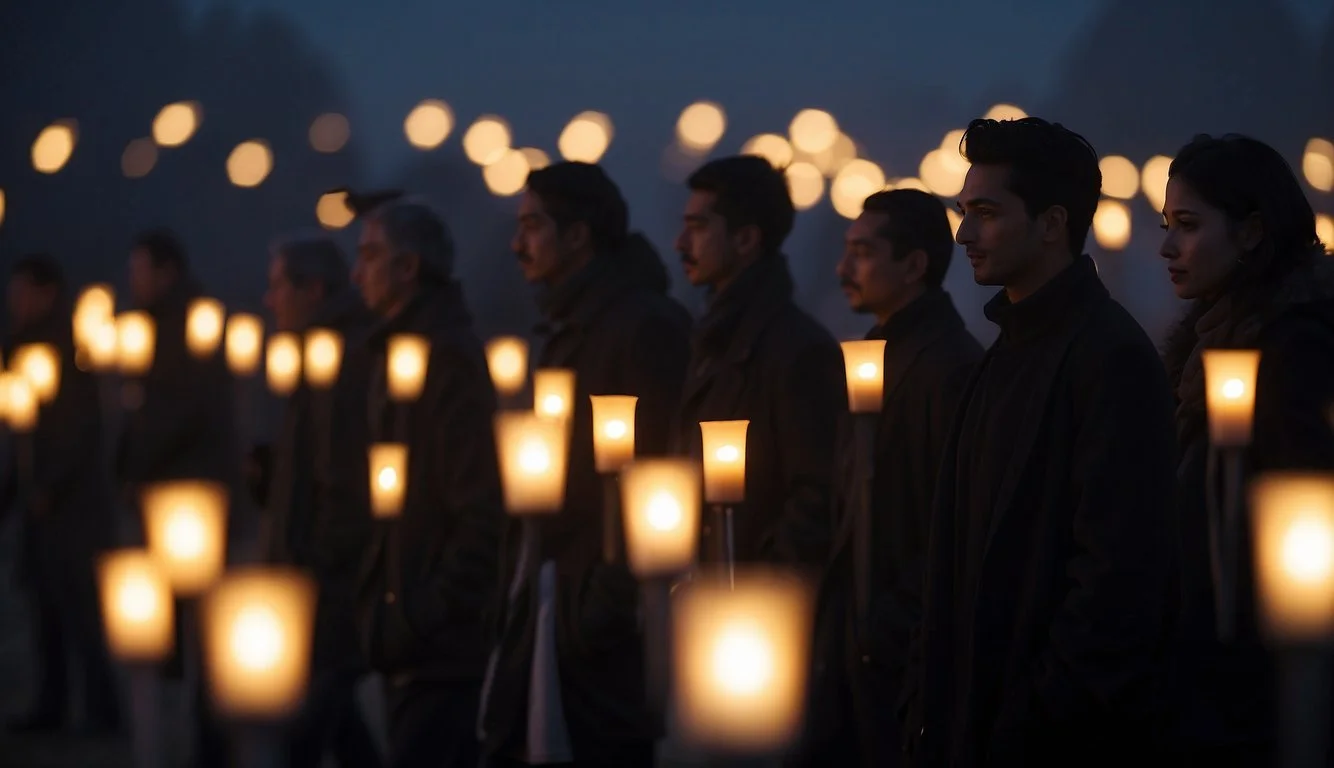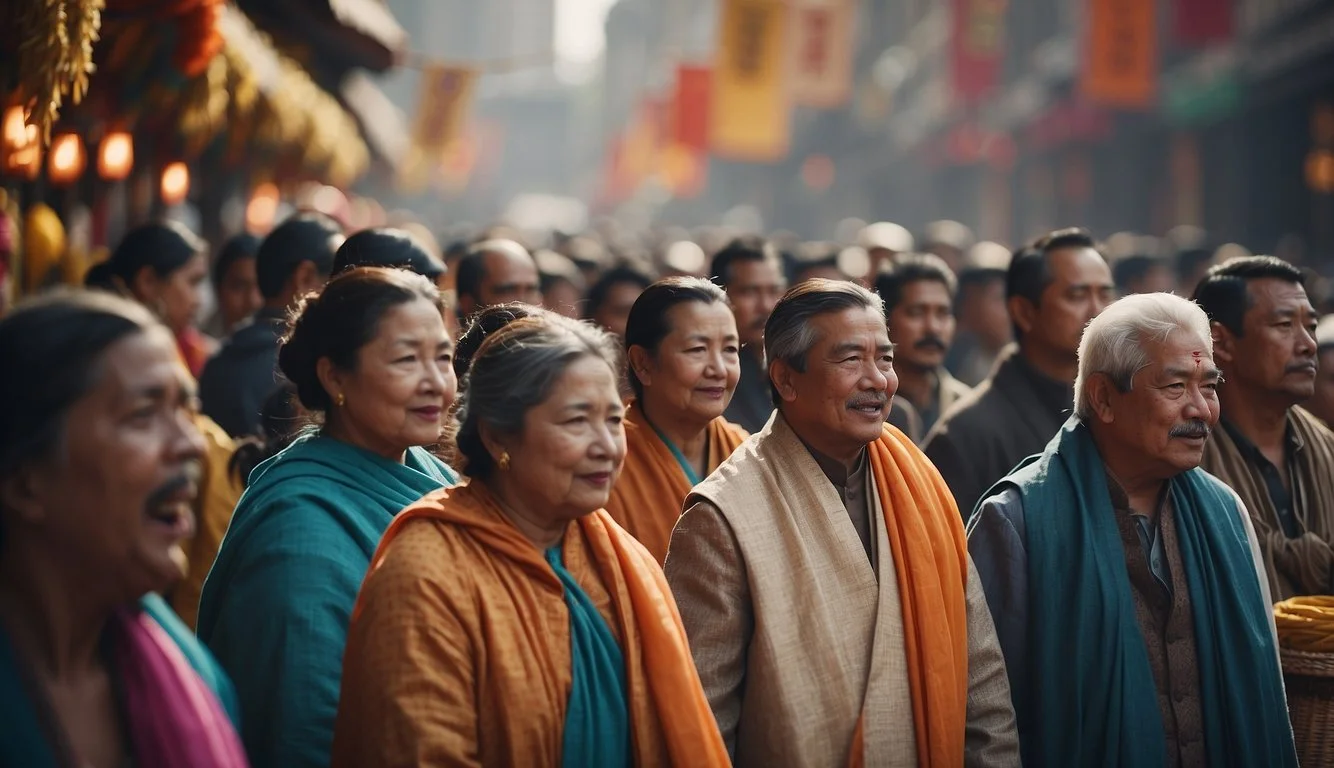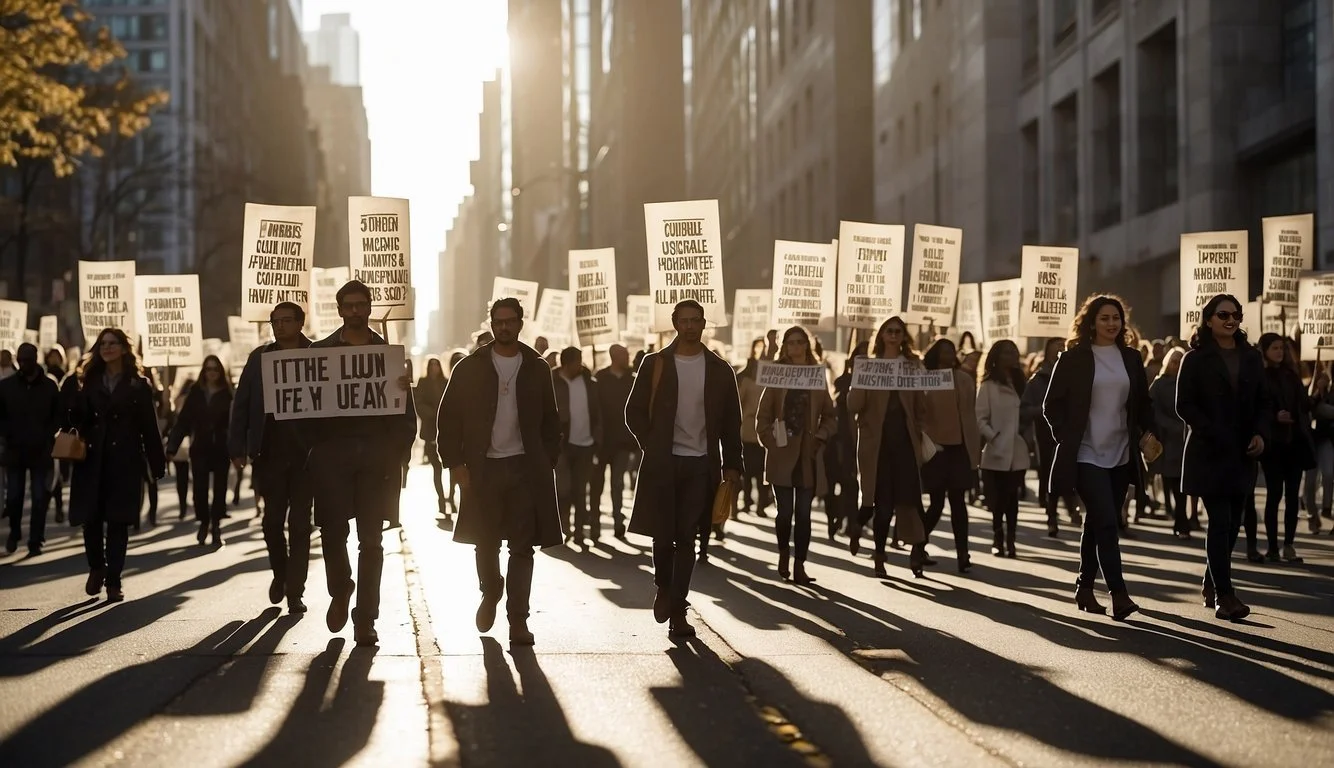Documentary Review: Procession (2021)
An Insightful Examination
"Procession" (2021) stands out as a unique documentary that brings together elements of nonfiction and drama to address the harrowing experiences of its participants. Directed by Robert Greene, the film focuses on six men, all survivors of childhood sexual abuse by Catholic priests. The documentary's approach is distinctive, allowing these survivors to regain a sense of agency through collaborative filmmaking.
Through a series of scripted scenes based on their trauma, the men in "Procession" use art as a medium for healing and closure. This creative process not only facilitates their recovery but also invites viewers to grapple with the profound impact of such abuses. By involving the survivors in every step of the production, "Procession" transforms the act of storytelling into a powerful therapeutic journey.
"Procession" has received critical acclaim for its innovative method and emotional depth, captivating audiences and critics alike. This documentary is not merely a recounting of past horrors; it’s a brave exploration of healing, solidarity, and resilience. Those interested in the intersection of art and therapy, as well as the enduring effects of trauma, will find "Procession" a compelling and necessary watch.
Synopsis of 'Procession'
Procession (2021), directed by Robert Greene, is an innovative documentary that combines elements of nonfiction and drama. The film centers on six men, all survivors of childhood sexual abuse by Catholic priests, as they engage in a unique collaborative filmmaking experiment.
These men work alongside the film crew to create short films that depict and reinterpret their traumatic experiences. This creative process serves as a form of therapy, aiming to help them find peace and possibly closure.
The documentary presents their stories with raw, emotional honesty, highlighting the profound impact of their past experiences. Through the film, the audience gains insight into the personal journeys of these men as they strive to reclaim their narratives and heal.
Procession runs for 1 hour and 58 minutes and is rated R due to its discussions of childhood trauma. The film’s collaborative approach includes giving directorial credit to all participants, reflecting its inclusive and therapeutic intent.
Background of the Documentary
"Procession" is a unique and impactful documentary directed by Robert Greene, focusing on the creative collaboration between survivors of childhood sexual abuse by Catholic priests and filmmakers.
Director's Perspective
Robert Greene is recognized for his innovative approach to documentary filmmaking. In "Procession," he collaborates with six men who survived sexual abuse by clergy. He employs a hybrid style that blends nonfiction and dramatized elements, giving each participant an active role in the creative process. The documentary is structured around the men creating and performing scripted scenes inspired by their traumatic experiences. Greene views this method as a means to facilitate catharsis and personal healing. By involving the survivors in the filmmaking, Greene shifts the narrative power to them, enabling a unique form of storytelling.
Historical Context
The documentary sheds light on the enduring crisis of sexual abuse within the Catholic Church. This crisis has spanned decades, with numerous reports and investigations revealing a pattern of abuse and cover-ups by clergy members. The historical context of "Procession" includes landmark events such as the Boston Globe's 2002 investigation, which exposed widespread abuse and prompted global awareness. The participants of "Procession" represent a fraction of the countless survivors whose lives have been profoundly affected by these crimes. By focusing on their stories, the documentary underscores the long-lasting impact of abuse and the importance of giving survivors a voice.
Documentary Structure Analysis
"Procession" (2021) employs innovative techniques that blend drama and nonfiction, offering a unique approach to storytelling. The documentary leverages narrative techniques, meticulous cinematography, and thoughtful editing to present a compelling and empathetic portrayal of trauma survivors.
Narrative Techniques
"Procession" uses a hybrid of traditional documentary and dramatic reenactments to tell the stories of survivors of childhood sexual abuse. Director Robert Greene collaborates with the participants, allowing them to create scripted scenes based on their traumatic experiences.
This collaborative approach gives agency to the survivors, enabling them to process their trauma through creative expression. The film avoids conventional linear storytelling, instead using a more fragmented and emotionally resonant structure. This technique helps to convey the complexity of the survivors’ experiences.
Cinematography
The film's cinematography, headed by Robert Kolodny, is carefully crafted to enhance the emotional depth of the narrative. The use of close-up shots captures the raw emotions of the participants, drawing viewers into their personal journeys.
Lighting plays a critical role, often casting stark contrasts that reflect the themes of light and darkness in the survivors' lives. The cinematography also utilizes a mix of static and dynamic shots to mirror the fluctuation between stability and chaos in the narratives.
Editing Style
The editing in "Procession" is purposeful and evocative. The film often intercuts between the reenactments and real-time interactions among the survivors. This creates a layered storytelling effect, allowing viewers to see the immediate impact of the creative process on the participants.
Editor Robert Greene employs a non-linear structure, which resonates with the non-sequential way trauma memories often manifest. The careful pacing ensures that every scene contributes to the overarching emotional and narrative arc. This measured approach not only builds tension but also allows for moments of reflection and catharsis.
Themes and Motifs
Procession delves into the profound effects of childhood trauma and the journey towards healing. It brings together survivors of abuse by priests, creating a collaborative environment where art becomes a form of therapy.
Healing Through Art
The film utilizes filmmaking as a medium for catharsis. Participants co-create scenes reflecting their experiences, which helps them process their trauma in a controlled, creative space.
Power Dynamics
A recurrent theme is the abuse of power. The documentary highlights how the Church's authority was misused, creating a systemic environment for abuse. Through reenactments, the survivors confront these power imbalances.
Community and Support
A sense of community and collective healing emerges as the survivors share their stories. The film shows the importance of support systems in overcoming trauma, underscored by their collaborative process.
Memory and Recollection
The theme of memory is crucial, as the film navigates how survivors recount and reconstruct their past. By filming their personal narratives, they regain control over their stories, leading to empowerment.
This multifaceted approach to storytelling emphasizes the complexities of trauma and the varied paths to recovery. By blending nonfiction and drama, Procession provides a unique, intimate look at resilience and the collective power of healing.
Subject Matter Treatment
"Procession" tackles the sensitive subject of childhood sexual abuse by Catholic priests. The film is directed by Robert Greene but emphasizes a collective effort. Six survivors participate, contributing to the creative process. This collaborative approach is a key aspect of the documentary's narrative.
The men engage in an innovative form of drama therapy. By scripting and acting out scenes based on their traumatic experiences, they seek catharsis and healing. This method is shown to be deeply impactful, not just for the participants but also for the audience.
Each scene created in the film is a personal reflection, allowing the men to confront their pasts in a controlled and supportive environment. This therapeutic process is portrayed with sensitivity and respect. It underlines the effectiveness of using art as a means of rehabilitation.
Various elements from production, including casting and brainstorming sessions, receive significant focus. These aspects highlight the collaborative essence of the project. The documentary presents these activities with authenticity, avoiding sensationalism.
The film's structure ensures that each survivor's story receives the necessary attention. This structure helps to maintain a balance between individual narratives and the collective journey. The use of titles and credits for all participants underscores the shared nature of the filmmaking experience.
In portraying the trauma and the healing process, "Procession" maintains a neutral and factual tone. The intention is to present the subject matter with integrity, offering an unbiased look at the survivors' attempts to reclaim their narrative through art.
Interviews and Testimonies
The documentary "Procession" features compelling interviews and testimonies from both survivors of clergy abuse and experts in trauma therapy. These stories are crucial for understanding the unique approach of the film in addressing childhood trauma through collaborative filmmaking.
Survivors' Stories
The core of "Procession" lies in the testimonies of six survivors: Tom, Dan, Joe, Ed, Michael, and Mike. Each of these men shares deeply personal accounts of their experiences with clergy abuse. Their stories highlight the long-lasting impact of the trauma and their courageous journey towards healing.
Through the collaborative process, these survivors not only recount their painful past but also engage in cinematic re-enactments. This method serves as a therapeutic tool, allowing them to confront and process their emotions in a creative and supportive environment. Their participation is both a testament to their resilience and a bold step towards personal closure.
Experts' Contributions
Robert Greene, the director, orchestrates the process with sensitivity and skill, ensuring that the survivors' voices are heard and respected. He collaborates closely with trauma therapists and other professionals to create a safe space for the participants.
Experts in trauma therapy provide valuable insights and guide the survivors through the filmmaking process. Their contributions are integral to the documentary, offering psychological support and emphasizing the therapeutic potential of creative expression. This blend of professional expertise and personal testimony creates a powerful narrative, enriching the documentary’s impact.
By including these expert perspectives, "Procession" adds depth to its examination of trauma and recovery, demonstrating the profound effects of collaborative storytelling in healing deep-seated wounds.
Public and Critical Reception
"Procession" has received significant attention from both audiences and critics since its release.
Roger Ebert's website highlights the unique collaborative aspect of the film. This involves survivors of childhood sexual abuse by priests participating in the creative process along with director Robert Greene.
The New York Times emphasizes the film's "discomfiting power" in portraying the trauma of its participants. The emotional impact of the narrative has struck a chord with many viewers.
Variety mentions the involvement of individuals such as Joe Eldred and Mike Foreman, underlining the deeply personal and powerful performances of the cast. This has been a key factor in the documentary's reception.
On Rotten Tomatoes, the documentary holds a favorable rating, praised for its refreshing and powerful presentation. User ratings and reviews reflect the film’s impact, with many highlighting its honest and raw depiction of sensitive issues.
Notable Reviews
Roger Ebert: "A testament to the collaborative effort of all participants."
The New York Times: "Shows and facilitates the process of working through trauma."
Variety: "Shattering doc that hands the reins to the abuse survivors."
These reviews mirror the public sentiment, which has been largely appreciative of the documentary's empathetic and authentic approach. This feedback underscores "Procession" as a significant and thought-provoking work in documentary filmmaking.
Impact on Society
"Procession" (2021) has significantly influenced public discourse by raising awareness about childhood sexual abuse and advocating for survivors. The film has also had a noticeable impact on policy discussions related to protecting vulnerable populations.
Awareness and Advocacy
"Procession" has succeeded in bringing the harsh realities of childhood sexual abuse into the public eye. By focusing on six men who were abused by Catholic priests, the documentary highlights the long-term effects of such trauma.
The collaborative filmmaking approach allows survivors to share their stories directly. This method empowers them and gives a platform to voices often silenced. Viewers are encouraged to empathize with the survivors’ journeys, creating a groundswell of support and understanding.
Survivor-led initiatives and organizations, inspired by the film, have gained momentum. They work tirelessly to educate the public and advocate for preventive measures. Public screenings and discussions have further amplified these efforts, fostering a community intent on addressing and preventing abuse.
Policy Influence
"Procession" has not only sparked conversations but has also influenced policy considerations. Legislators and policymakers have taken note of the film's stark portrayal of abuse and its consequences. This increased attention has led to discussions about stricter laws and regulations to protect children.
The film’s exposure has pressured institutions, such as the Catholic Church, to be more transparent and accountable. Policymakers are now more likely to propose and support bills focused on abuse prevention and survivor support.
Institutions have also faced public pressure to implement more stringent background checks and reporting mechanisms. "Procession" serves as a catalyst for these critical changes, demonstrating the power of documentary filmmaking in influencing public policy.
Comparative Analysis
The film Procession (2021) intersects with various other documentaries that explore trauma and healing. This analysis provides a comparative overview, examining how Procession fits within broader genre trends alongside related films.
Related Documentaries
Procession shares thematic similarities with other documentaries that tackle abuse and trauma. For example, The Keepers (2017) investigates sexual abuse within the Catholic Church, highlighting survivors' stories and the institutional failures that allowed such abuse to continue. Another film, Deliver Us from Evil (2006), also delves into clerical abuse, focusing on a specific priest and his many victims.
Unlike traditional documentaries, Procession employs a participatory method, allowing survivors to create re-enactments of their traumatic experiences. This innovative approach is seen in Minding the Gap (2018), where the subjects actively engage in the storytelling process, offering a unique perspective on personal and communal trauma.
Genre Evolution
Documentary filmmaking has evolved significantly, embracing more interactive and hybrid forms. Traditional formats often relied on linear narratives and interviews. Films like Stories We Tell (2012) and The Act of Killing (2012) introduced creative storytelling techniques and re-enactments, setting precedents that Procession expands upon.
Procession exemplifies this evolution by integrating drama and therapy, creating a multifaceted viewing experience. The documentary breaks away from didactic storytelling, offering a more immersive and participatory model. This evolution reflects a broader trend towards documentaries that do more than just inform but also engage and involve subjects in the narrative process.
Conclusion
"Procession" stands out for its innovative approach to documenting trauma recovery. The collaboration between the survivors and director Robert Greene creates a powerful narrative.
The structured scenes, scripted by the survivors, provide a unique lens into their personal stories. This method offers them a measure of control over their traumatic experiences.
Each survivor brings a distinct perspective, enriching the documentary. Their collective journey showcases the complexities of healing from abuse.
The visual and emotional impact of "Procession" is amplified by its candidness. The transparency in the filmmaking process adds layers of authenticity.
The film's collaborative aspect ensures that the voices of the survivors are central. This makes the documentary not just a narrative, but a therapeutic endeavor for those involved.








